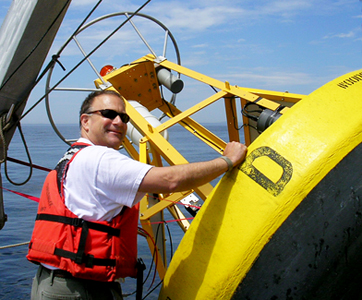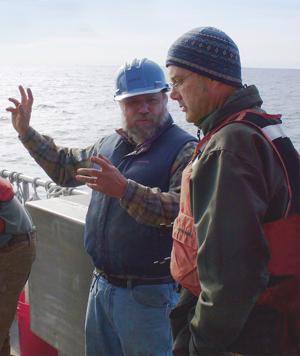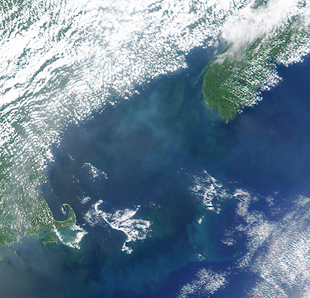Winter 2011
FOR THE PAST FIVE YEARS, a sentinel buoy has bobbed about in waters northeast of Appledore Island in the Gulf of Maine taking hourly readings of both atmospheric and oceanic CO2. It is one of just half a dozen such buoys nationwide making a crucial measurement to help scientists know how much carbon the ocean is taking up globally as atmospheric CO2 levels continue to rise.
More specifically, the Gulf of Maine buoy measurements are aimed at better understanding the role complex coastal waters play in the increasing acidification of the global ocean.
 |
||
| Oceanographer Joe Salisbury with the UNH CO2 buoy being deployed from the R/V Gulf Challenger. Photo courtesy of James Irish, UNH |
||
“We’re trying to understand how much carbon the ocean is taking up globally,” says research associate professor Doug Vandemark of the Ocean Process Analysis Laboratory and principal investigator on the CO2 buoy. He adds, “And one of the big questions is, If we don’t make measurements along our coasts, are we missing a big part of the picture?”
In a word, yes. Unlike open ocean waters, which have been monitored for CO2 levels much more extensively, coastal ocean waters are a complicated mix of intense, seasonal biological activity and inflowing river waters that flush nutrients, sediments, and pollutants directly into the sea. In addition, short-term events like storms, large spring snowmelts, flooding, and even seasonal air pollution plumes can have an influence on the uptake of CO2 in coastal oceans.
In a word, yes. Unlike open ocean waters, which have been monitored for CO2 levels much more extensively, coastal ocean waters are a complicated mix of intense, seasonal biological activity and inflowing river waters that flush nutrients, sediments, and pollutants directly into the sea. In addition, short-term events like storms, large spring snowmelts, flooding, and even seasonal air pollution plumes can have an influence on the uptake of CO2 in coastal oceans.
And because there is so much mixing that goes on in coastal ocean waters, taking accurate readings of CO2 levels is much more challenging than in pelagic seas.
“The coastal ocean mixes faster than we can monitor using traditional shipboard sampling,” says Vandemark. “With a ship we might go out once a week at best, and it’s a lot of effort, a lot of time and expense. So having a buoy out there making hourly measurements helps us to deal with these issues in a pragmatic way.”
Not that the buoy didn’t require tremendous effort and skill to get up and running, improve, and keep maintained. Vandemark notes that without the engineering expertise of Jim Irish, former OPAL faculty and now a research professor in the UNH Center for Ocean Engineering, the technical prowess of OPAL research scientist Shawn Shellito, and the skill of the crew on the UNH Research Vessel Gulf Challenger, the buoy would never have gotten off the ground, literally.
 |
|||
| Jim Irish of Ocean Engineering (left) and Doug Vandemark of the Ocean Process Analysis Laboratory onboard the Gulf Challenger. Photo courtesy of James Irish, UNH |
|||
Increasing the buoy’s effectiveness was the recent addition of a pH sensor that will make a direct measurement of ocean acidity/alkalinity levels. In tandem with the CO2 readings this makes the buoy a more complete, long-term ocean acidification monitoring platform, which aligns well with NOAA’s future plans. Current funding for the buoy comes from the National Science Foundation and NOAA.
When the buoy “got wet” five years ago in May, NOAA’s Pacific Marine Environmental Laboratory, which built the $60,000 CO2 instrument on the UNH buoy, had a target of some 60 such buoys scattered around to gauge global CO2 levels. But with the issue of ocean acidification coming to the fore in the interim, the emphasis is now on establishing a network of ocean acidification buoys with the hope they will be reading the waters for the next decade and beyond.
Says Vandemark, “The issue of ocean acidification is certainly saturating our field of ocean sciences. It’s a very pressing topic and one that has chemists, biologists, and fisheries people very concerned.”
One of the chief concerns is the impact acidic ocean water has on depleting naturally occurring, calcium carbonate minerals that both buffer the acidity (i.e., make the water more alkaline, or think of eating some Rolaids to relieve heartburn) and serve as the building blocks for shell making.
Shellfish larvae, including those of clams, mussels, and scallops, begin their lives in shallow coastal waters where they must begin building their protective shells immediately. They do so by pulling calcium carbonate out of seawater. But as seawater becomes more acidic the critical ingredient is in shorter supply as it is used to buffer the water itself. Indeed, if the acidity level exceeds a certain threshold the process goes in reverse and shells begin to disintegrate.
Research assistant professor Joe Salisbury is co-investigator on the CO2 buoy and is specifically investigating how biological activities – the seasonal burst in the birth and growth of critters from phytoplankton to fish and shellfish – are affecting the carbon fluxes of coastal waters.
“In addition to the atmosphere’s influence on oceanic carbon levels, there is this biological perturbation that I’m interested in and that we don’t know much about,” Salisbury says. “But we do know that it’s extremely variable near the coast.”
It is also known that the Gulf of Maine’s coastal waters are cold and relatively poorly buffered and, thus, could be particularly vulnerable to the effects of increased acidification.
“So these coastal waters could be more sensitive than, say, adjacent regions to the northeast or south, which are similar but tend to be better buffered,” Salisbury notes.
One, Two, Three Equals Buffering Capacity
The Gulf of Maine buoy, particularly with the recent addition of the pH sensor, is a critical tool for getting a complete picture of these coastal waters vis-à-vis increased ocean acidification. By adding the pH sensor the scientists can now determine – hourly, 24/7 – what the precise buffering capacity of the waters is. It’s as simple as one, two, three.
 |
|||
| A satellite image of the Gulf of Maine showing trillions of calcite (limestone) coated phytoplankton known as coccolithophores. Photo courtesy of NASA Earth Observatory |
|||
Having both CO2 and pH provides the variables to “solve for the carbonate equilibrium equations,” Salisbury explains. In other words, the scientists can now easily gauge the total inorganic carbon concentration of the waters – the buffering capacity – and, in turn, Salisbury can use this to further delve into the mysteries of how the biological processes that occur in coastal waters affect fluxes in ocean acidification.
In the early 1990s it was thought that high productivity coastal areas, such as the Gulf of Maine, should be sinks for CO2 – that they would sequester CO2 and that it would be “lost” to deep water for a thousand years.
“But,” says Salisbury, “what we’re finding in the Gulf of Maine is that although the biology is working really hard to take up CO2 during the spring and summer, the system is not sequestering much carbon. What gets fixed tends to be released back up to the atmosphere, so there’s sort of a no-net gain.”
Which is not good news in the face of rising levels of acidity in global oceans, and which comes back full circle to the UNH-NOAA buoy.
“The reason why these observations are important, and why NOAA is so focused on them, is that we don’t yet have accurate predictive models for how carbon moves between the atmosphere and ocean, and the land and the ocean,” explains Vandemark, whose research interests focus on the study of ocean and atmosphere boundary layer interactions.
One of the next steps for Vandemark and Salisbury is to begin collaborative work with modeling groups around the country in an effort to test and improve the models of carbon uptake in the coastal oceans in the northeast and the Gulf of Maine.
Says Vandemark, “The question the scientific community is trying to refine, and which models will help answer is, How much atmospheric carbon dioxide is the ocean taking up in general and, if that uptake rate changing, is it weakening?”
And, adds Salisbury, while there may be continued debate in some lofty scientific circles over whether or not the increasing ocean acidification is within the bounds of natural variability, the fact remains that isotope research has shown “we haven’t seen this type of change in acidity in 65 million years.”
